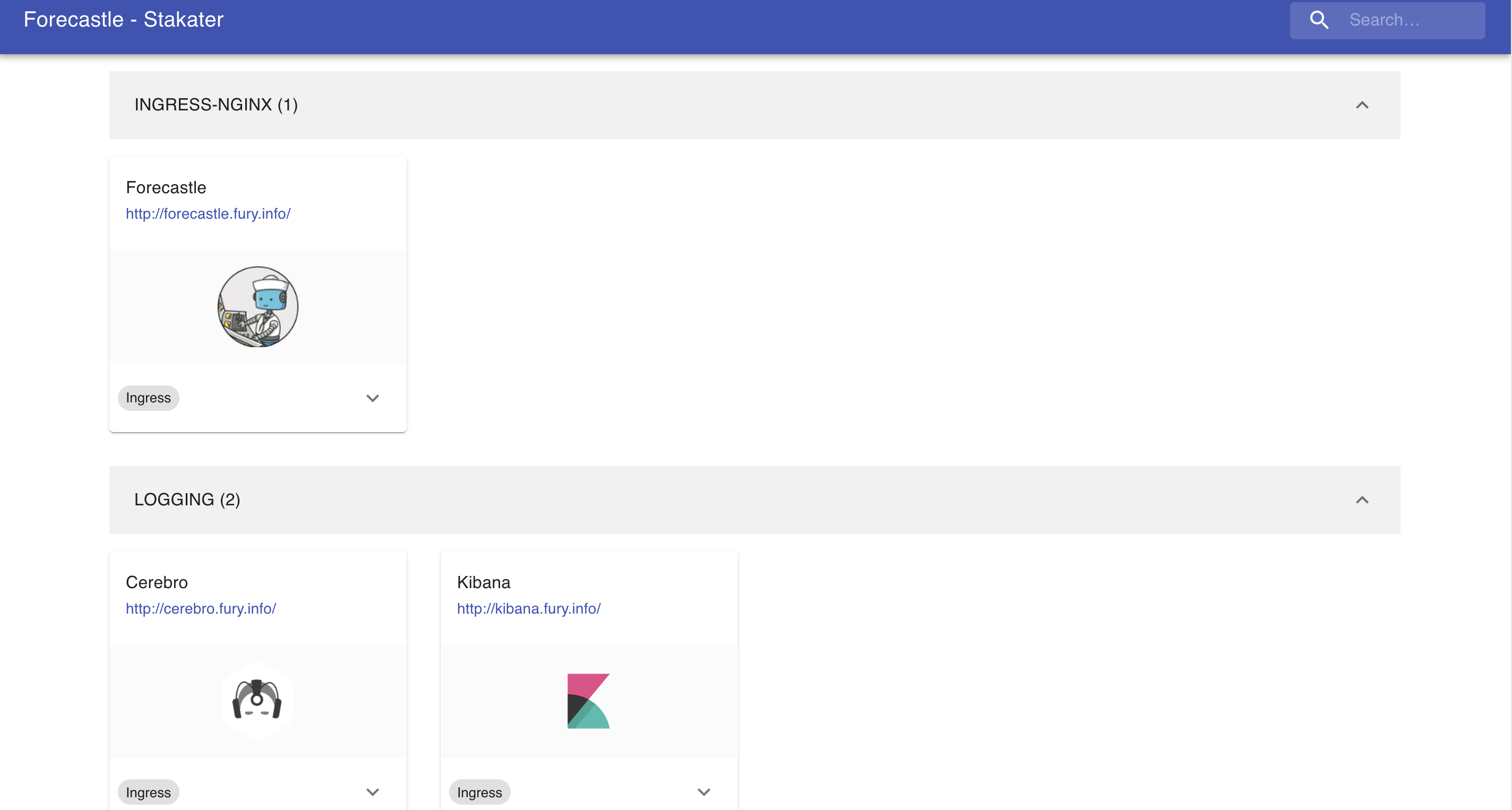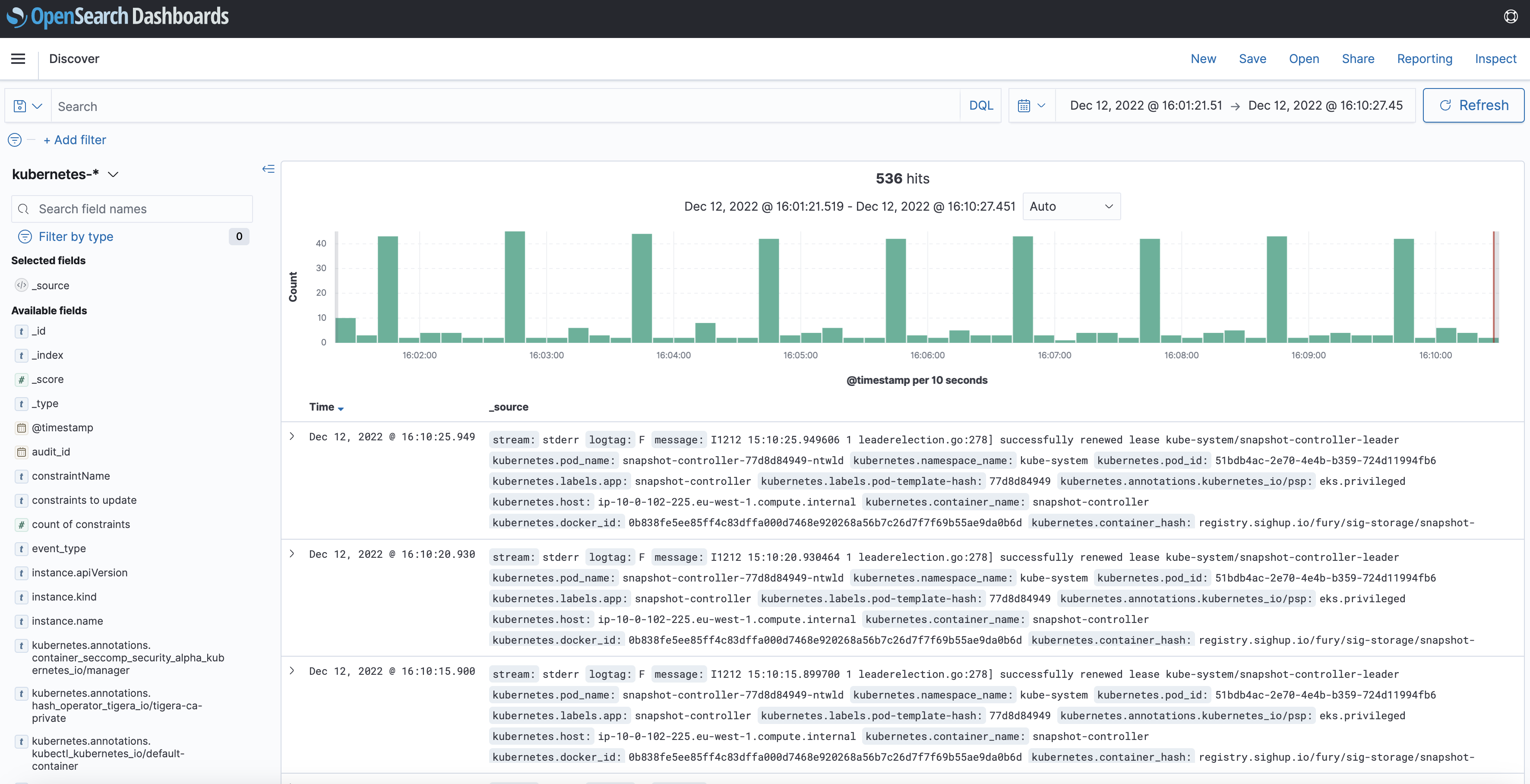Fury on Minikube
This step-by-step tutorial helps you deploy a subset of the Kubernetes Fury Distribution on a local minikube cluster.
This tutorial covers the following steps:
- Deploy a local Minikube cluster.
- Download the latest version of Fury with
furyctl. - Install Fury distribution.
- Explore some features of the distribution.
- Teardown the environment.
☁️ If you prefer trying Fury in a cloud environment, check out the Fury on EKS tutorial or the Fury on GKE tutorial.
The goal of this tutorial is to introduce you to the main concepts of KFD and how to work with its tooling.
Prerequisites
This tutorial assumes some basic familiarity with Kubernetes.
To follow this tutorial, you need:
- Minikube - follow the installation guide. This guide is based on Minikube with the VirtualBox driver.
- Docker - we provide you with a Docker image containing
furyctland all the necessary tools.
Setup and initialize the environment
Open a terminal
Clone the fury getting started repository containing all the example code used in this tutorial:
git clone https://github.com/sighupio/fury-getting-started/
cd fury-getting-started/fury-on-minikube
Step 1 - Start the minikube cluster
- Start minikube cluster:
export REPO_DIR=$PWD
export KUBECONFIG=$REPO_DIR/infrastructure/kubeconfig
cd $REPO_DIR/infrastructure
make setup
⚠️ This command will spin up by default a single-node Kubernetes v1.24.9 cluster, using VirtualBox driver, with 4 CPUs, 8GB RAM and 20 GB Disk. Take a look at the Makefile to change the default values.
You can also pass custom parameters, for example:
make setup cpu=4 memory=4096 driver=hyperkit
- Run the
fury-getting-startedcontainer:
docker run -ti --rm \
-v $REPO_DIR:/demo \
--env KUBECONFIG=/demo/infrastructure/kubeconfig \
--net=host \
registry.sighup.io/delivery/fury-getting-started
- Test the connection to the Minikube cluster:
kubectl get nodes
Output:
NAME STATUS ROLES AGE VERSION
minikube Ready control-plane 104s v1.24.9
Step 2 - Download fury modules
furyctl can do a lot more than deploying infrastructure. In this section, you use furyctl to download the monitoring, logging, and ingress modules of the Fury distribution.
To learn more about furyctl and its features, head to the documentation site.
Inspect the Furyfile
furyctl needs a Furyfile.yml to know which modules to download.
For this tutorial, use the Furyfile.yml located at /demo/Furyfile.yaml, here is its content:
versions:
monitoring: v2.0.1
logging: v3.0.1
ingress: v1.13.1
bases:
- name: monitoring/prometheus-operator
- name: monitoring/prometheus-operated
- name: monitoring/alertmanager-operated
- name: monitoring/grafana
- name: monitoring/kubeadm-sm
- name: monitoring/configs
- name: monitoring/kube-state-metrics
- name: monitoring/node-exporter
- name: logging/opensearch-single
- name: logging/opensearch-dashboards
- name: logging/logging-operator
- name: logging/logging-operated
- name: logging/configs
- name: logging/cerebro
- name: ingress/nginx
- name: ingress/cert-manager
- name: ingress/forecastle
Download Fury modules
- Download the Fury modules with
furyctl:
cd /demo/
furyctl vendor -H
- Inspect the downloaded modules in the
vendorfolder:
tree -d /demo/vendor -L 2
Output:
/demo/vendor
└── katalog
├── ingress
├── logging
└── monitoring
Step 3 - Installation
Each module is a Kustomize project. Kustomize allows to group together related Kubernetes resources and combine them to create more complex deployments. Moreover, it is flexible, and it enables a simple patching mechanism for additional customization.
To deploy the Fury distribution, use the following root kustomization.yaml located /demo/manifests/kustomization.yaml:
---
apiVersion: kustomize.config.k8s.io/v1beta1
kind: Kustomization
resources:
# Monitoring
- ../vendor/katalog/monitoring/prometheus-operator
- ../vendor/katalog/monitoring/prometheus-operated
- ../vendor/katalog/monitoring/grafana
- ../vendor/katalog/monitoring/kube-state-metrics
- ../vendor/katalog/monitoring/node-exporter
- ../vendor/katalog/monitoring/alertmanager-operated
# Logging
- ../vendor/katalog/logging/opensearch-single
- ../vendor/katalog/logging/opensearch-dashboards
- ../vendor/katalog/logging/logging-operator
- ../vendor/katalog/logging/logging-operated
- ../vendor/katalog/logging/configs/audit
- ../vendor/katalog/logging/configs/events
- ../vendor/katalog/logging/configs/ingress-nginx
- ../vendor/katalog/logging/configs/kubernetes
- ../vendor/katalog/logging/cerebro
# Ingress
- ../vendor/katalog/ingress/forecastle
# Ingress definitions
- resources/ingress.yml
# With this patches, we customize the default configuration of the modules,
# for example lowering the resource requirements to make it run in minikube.
patchesStrategicMerge:
- patches/alertmanager-operated-replicas.yml
- patches/alertmanager-operated-resources.yml
- patches/prometheus-operated-resources.yml
- patches/grafana-resources.yml
- patches/opensearch-resources.yml
- patches/logging-operated-resources.yml
This kustomization.yaml:
- references the modules downloaded in the previous section
- patches the upstream modules (e.g.
patches/opensearch-resources.ymllimits the resources requested by OpenSearch) - deploys some additional custom resources (e.g.
resources/ingress.yml)
Install the modules:
cd /demo/manifests/
make apply
# Wait a moment to let the Kubernetes API server process the new APIs defined by the CRDs and for the NGINX Ingress Controller pod to be ready and apply again
make apply
Step 4 - Explore the distribution
🚀 The (subset of the) distribution is finally deployed! In this section you will explore some of its features.
Setup local DNS
In Step 3, alongside the distribution, you have deployed Kubernetes ingresses to expose underlying services at the following HTTP routes:
directory.fury.infografana.fury.infologs.fury.info
To access the ingresses more easily via the browser, configure your local DNS to resolve the ingresses to the external Minikube IP:
ℹ️ the following commands should be executed in another terminal of your host. Not inside the fury-getting-started container.
- Get the address of the cluster IP:
minikube ip
<SOME_IP>
- Add the following line to your local
/etc/hosts:
<SOME_IP> directory.fury.info alertmanager.fury.info grafana.fury.info prometheus.fury.info logs.fury.info
Now, you can reach the ingresses directly from your browser.
Forecastle
Forecastle is an open-source control panel where you can access all exposed applications running on Kubernetes.
Navigate to http://directory.fury.info to see all the other ingresses deployed, grouped by namespace.

OpenSearch Dashboards
OpenSearch is an open-source analytics and visualization platform. OpenSearch Dashboards lets you perform advanced data analysis and visualize data in various charts, tables, and maps. You can use it to search, view, and interact with data stored in Elasticsearch indices.
Navigate to http://logs.fury.info or click the OpenSearch Dashboards icon in Forecastle.
ℹ️ you might get a message saying that the Indexes have not been created yet. This is expected for some minutes the first time you deploy the logging stack. There are some jobs defined that take care of creating them but may not have run yet.
Read the logs
To work with the logs arriving into the system, click on "OpenSearch Dashbaords" icon in the main page, and then on the "Discover" option or navigate through the side ("hamburger") menu and select Discover.

You can choose here between different index options on the left side (Kubernetes logs, systemd logs, audit logs, etc.) and then search them by writing queries in the search box. You can also filter the results by some criteria, like pod name, namespaces, etc.
Grafana
Grafana is an open-source platform for monitoring and observability. Grafana allows you to query, visualize, alert on and understand your metrics.
Navigate to http://grafana.fury.info or click the Grafana icon from Forecastle.
Fury provides pre-configured dashboards to visualize the state of the cluster and all its components. Examine an example dashboard:
- Click on the search icon on the left sidebar.
- Write
podsand press enter. - Select the
Kubernetes/Podsdashboard.
This is what you should see:

Take a look around and test the other dashboards available.
Step 6 - Tear down
- Stop the docker container:
# Execute this command inside the Docker container
exit
- Delete the minikube cluster:
# Execute these commands from your local system, outside the Docker container
cd $REPO_DIR/infrastructure
make delete
Conclusions
Congratulations, you made it! 🥳🥳
We hope you enjoyed this tour of Fury!
Issues/Feedback
In case your ran into any problems feel free to open an issue in GitHub.
Where to go next?
More tutorials:
More about Fury: